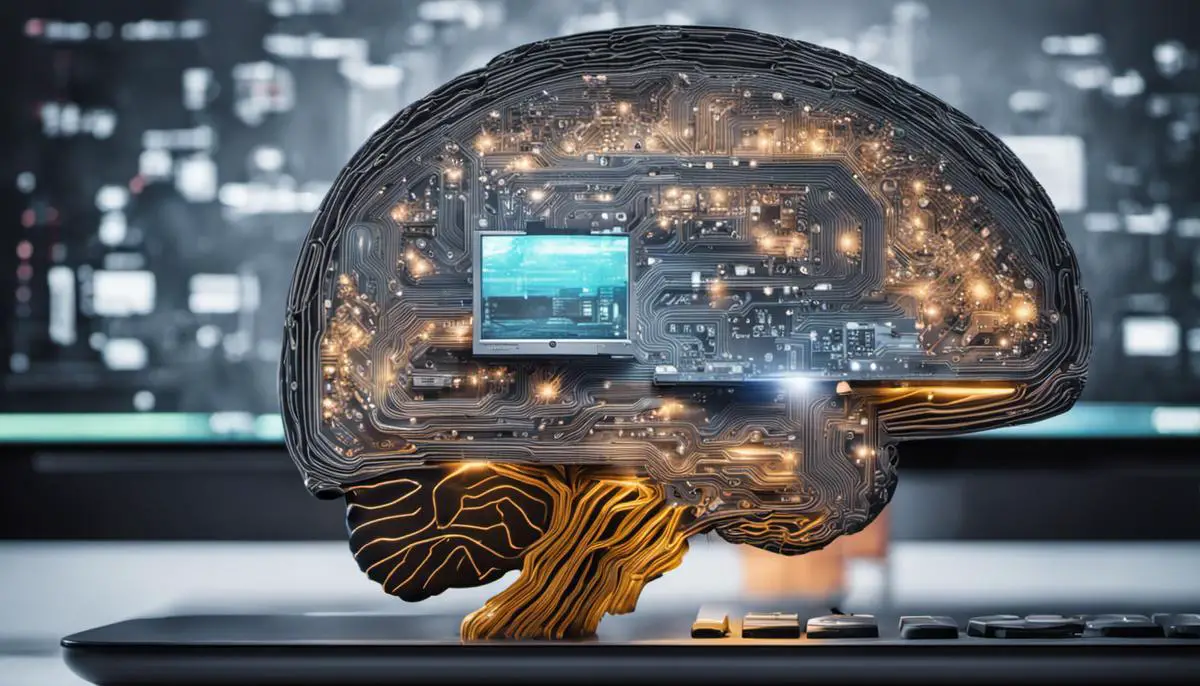As design intersects with innovative technology, the principles of graphic design are undergoing an exciting transformation. This discourse presents an engaging examination of the interface of Artificial Intelligence (AI) with the arena of graphic design, shedding light on the underpinning principles of AI and its extensive capabilities.
Unfolding the vast potential of technologies such as machine learning and automation, this exploration dives into the realm of AI integrations in a myriad of graphic design applications. From contemplating how AI is currently revolutionizing the field to forecasting the shape of things to come, this detailed enquiry provides a holistic perspective on the future of design in an AI-infused environment.
Contents
Understanding Artificial Intelligence In Graphic Design
Understanding Artificial Intelligence (AI)
Artificial Intelligence (AI), as an academic field, was founded on the claim that human intelligence can be simulated so precisely that machines can mimic it. This includes learning, reasoning, problem solving, perception, and language understanding.
Machine Learning (ML), a subset of AI, involves the development of computer programs that can access and process data to learn for themselves and improve from experience, without being explicitly programmed. Deep Learning, a more precise subfield of ML, tries to mimic the workings of the human brain in processing data for making decisions.
AI in Graphic Design
In graphic design, AI can substantively improve workflows and boost creativity. Generally, designs require a significant input of time, resources, and effort, especially if the designer starts from scratch.
However, AI helps designers generate numerous design elements and variations in a matter of seconds, allowing the designer to choose their favorite. AI programs can provide suggestions when you start a new project, allowing for a more efficient brainstorming process.
Automation in Design Process
One significant advantage AI brings to graphic design is automation. Automation helps in completing routine and repetitive tasks quickly and accurately. In graphic design, tasks such as cropping images, generating color schemes or resizing can all be automated with the help of AI.
This allows designers to focus more on other strategic and creative responsibilities. With the introduction of AI-driven design software like Adobe Sensei, CorelDraw, and Canva, the automated design process has been made easier and more efficient.
Data Analytics in Graphic Design
Data analytics is another area where AI plays a significant role in graphic design. AI can track user interaction with design elements and provide valuable insights based on customer behavior, which designers can use to improve UI/UX and make more data-driven decisions.
With AI, designers can predict how customers will react to their designs and adjust them accordingly. This personalizes interactions and maximizes user engagement.
Adaptation to the new Era
Adapting to AI in the graphic design field requires a shift in how traditional design processes are viewed. Designers need to embrace AI as an assistant that offers beneficial tools, rather than as a threat that could replace them. By integrating AI into their workflow, designers can speed up their processes, make smarter design decisions, reduce overload, and ultimately, create more engaging designs.
The need for technology skills in addition to traditional design skills will also be critical in this new era. A background in computer science, data analysis, or machine learning would greatly aid any graphic designer wishing to capitalize on the possibilities AI presents.
Unfolding Opportunities with AI in Graphic Design
The fusion of AI and graphic design is presenting boundless opportunities. Tools are not just getting smarter, but are also contributing to the origination of data-influenced design trends, generation of personalized user experiences, and significant savings on time and resources.
Moreover, they’re infusing more creativity into the design sphere. As AI technology continues to evolve, it’s integration with graphic design is anticipated to instigate a radical transformation, introducing unique capabilities and raising the standards in design.

Impact of AI on Graphic Design
The Emergence of AI Across Graphic Design Sectors
The influence of artificial intelligence is visible across diverse sectors, not excluding the key area of graphic design. The incorporation of AI in this field is triggering a revolution by imparting automation to ordinary tasks, thereby, enhancing efficiency.
With AI-driven design tools, it’s becoming less challenging for graphic designers to create professional-standard designs with minimal inputs and within a shorter time frame. To exemplify, platforms like Canva are utilizing AI to automate various aspects of the design creation process, whether it’s about designing professional branding or creating everyday social media graphics.
Powerful software like Adobe Sensei makes use of both artificial intelligence and machine learning to optimize workflow and deliver sophisticated design solutions more effectively.
These AI-guided tools provide recommendations based on an understanding of the designer’s preferences and specific project considerations. Suggestions can range from harmonizing color schemes, pairing font types, to managing dynamic media and much more.
Personalization and Mass Customization
AI has increasingly paved the way for mass customization and personalization in graphic design. It utilizes user-interactive data to personalize designs and makes it possible to create thousands of variations within minutes.
This has given businesses better strategies for impressing their customers with personalized content. Examples of AI-driven design personalization are abundant in the online advertising industry, where each ad is uniquely crafted for the individual viewer.
Inspiring Creativity
Not only does AI save time and foster efficiency, it also empowers graphic designers to push their creativity to new limits. AI platforms can generate numerous variations of a design concept, allowing designers to experiment with different elements without having to start from scratch each time. This provides a new canvas for designers to draw inspiration from and stimulate their own creative ideas.
AI and Job Displacement
Despite the benefits of AI in graphic design, there are concerns about job displacement. Automation of tasks has the potential to render some roles obsolete. However, it’s crucial to note that while AI can take over certain technical aspects of design, the human touch remains integral in the process. Creativity, personal touch, and emotional intelligence in design are aspects that cannot be replaced by AI. Graphic design, at its core, is about telling a story and connecting with viewers on an emotional level – a task best suited for humans.
Case Studies
Several industry-leading companies have embraced AI in their graphic design strategies. Netflix, for example, uses AI to create personalized artwork for its users based on their viewing history. Each viewer sees a unique version of the program cover, specifically designed to appeal to their tastes.
Another example is Wix’s Artificial Design Intelligence (ADI) that designs unique websites by learning about the user’s needs. The AI tool generates a site layout, color scheme, and even content based on its understanding of the user’s preferences – making customization and personalization faster than ever before.
Closing Thoughts
While it is undisputed that AI is revolutionizing the landscape of graphic design, it’s also essential to consider the potential implications for job displacement. By streamlining the design process, facilitating large-scale personalization, and pushing the boundaries of traditional creativity, AI offers indisputable opportunities. However, the evolving era of AI and graphic design rests on a delicate equilibrium – maximizing technology utilization without overshadowing the indispensable human aspect of the design process.

Case Studies and Applications of AI in Graphic Design
Reinvention of Graphic Design Through AI
In the graphic design arena, Artificial Intelligence has been subtly transforming the traditional methods of creating eye-catching visual content. Automated logo design systems are among the earliest and more practical instances of AI application in this industry.
Machine learning-based tools like Looka and Hatchful aid users in the logo making process. These futuristic tools consider varied inputs such as the nature of business, preferred color schemes, and design orientations to swiftly generate a multitude of unique design variations.
Intelligent Design Systems and AI
AI-powered intelligent design systems are pushing the envelope of conventional design methods. These systems, like Adobe Sensei, utilize advanced algorithms to automate mundane processes, foster creativity, and predict design trends.
For example, Adobe Sensei’s Auto Reframe feature automatically recognizes the point of interest in any video and reframes it for different social media platforms, significantly reducing the time-consuming manual labor. It also leverages AI to enhance tools such as Content-Aware Fill, which realistically fills in the gaps when you remove an object from an image or a video.
Expert Opinions on AI in Design
Amongst professionals in the design industry, there is a growing anticipation of the transformative potential of AI. Renowned graphic designer, Neville Brody, stated in an Adobe seminar, “AI can act as a design partner, supplying new forms of creativity we could not consider or have the time to do.”
This sentiment is also echoed in the 2020 Creative Trend report by Shutterstock, where several design experts foresee AI as a pivotal tool in shaping future creative trends by processing and analyzing large volumes of data to predict design inclinations.
AI and Design: Statistics
Survey reports corroborate the increasing acceptance of AI in the design community. According to a 2019 study by Logo Maker, more than 50% of design professionals think that automated design tools will become a norm in the graphic design industry in the next 5 years. They believe that AI can automate basic design tasks, freeing designers to channel their energy towards more creative and conceptual tasks.
The Evolution of AI in Graphic Design
Over recent years, AI has made vast strides in the realm of graphic design, yet the journey of development is far from finish. Experts in the industry foresee the forthcoming design systems to incorporate more advanced AI abilities, which will facilitate the understanding of human behavior, consumer tastes, and current design trends. The degree of advancement may reach a point where AI tools won’t just assist in designing, but will also play a substantial part in formulating concepts, thereby launching a groundbreaking era in design.
Nonetheless, while AI presents noteworthy potential, there’s a strong emphasize on the irreplaceability of human creativity. While AI can streamline tasks and detect trends, the role of a human designer remains crucial for interpreting, innovating, and artistically implementing these trends. Hence, it is anticipated that AI and designers will collaborate in the coming future, rather than AI replacing them, to generate more visually engaging and effective designs.
Future of AI in Graphic Design
Crossroads of Artificial Intelligence and Graphic Design
Artificial Intelligence, with its potential to replicate human intelligence and behavior, has given a new dimension to numerous sectors, including graphic design. AI’s application in graphic design leads to the inception of novel and visually stunning designs, garnering increasing attention from industries such as advertising, education, media, and entertainment.
Emerging Trends in AI and Graphic Design
AI-based design tools are breaking traditional boundaries by simplifying the graphic design process. Designers no longer need to manually perform intricate tasks as AI-powered software can analyze design trends and automatically generate designs based on specified parameters. Additionally, AI allows for instant customization and personalization to cater to the specific needs and wants of the audience, saving considerable time and effort.
In terms of data visualization, AI has the powerful ability to convert complex and extensive data sets into aesthetically pleasing and easily comprehensible visual graphics. Furthermore, AI tools can constantly learn from user behavior and feedback through machine learning algorithms, which facilitate the creation of more impactful and targeted designs over time.
The Transforming Role of Designers
With the advent of AI in design, the role of graphic designers is evolving. While AI provides efficiency, speed, and precision, creative judgement remains an inherently human trait. Designers are shifting from solely creating designs to also teaching AI algorithms how to design. The main focus is now collaborating with AI tools to achieve better results, combining the best of human creativity with the efficiencies of automated design technology.
Predictions for the Future
Looking into the future of AI in graphic design, industry leaders and researchers predict that as AI becomes more sophisticated and intuitive, it will become an indispensable tool for designers. AI’s potential is vast, with the likelihood of it enabling generation of designs from mere descriptions or even being able to understand and process human emotions to create emotionally-responsive designs.
The integration of AI in the field of graphic design marks a new era, offering endless possibilities and setting the stage for the future of the design industry. The ability of AI to perform repetitive tasks and analyze vast amounts of data opens the door for designers to focus more on the creative aspects and strategic thinking, leading to a new landscape where technology and creativity coexist harmoniously.
Practical Experiences and Opinions of Professionals
Across the industry, professionals who have incorporated AI into their work have noted a significant increase in productivity and consistency. They appreciate the speed at which AI can create and modify designs, but emphasize the need for a human touch to ensure designs resonate on an emotional level. Industry leaders have stressed the importance of education and skill-building in AI tools, to navigate this swiftly changing technological environment successfully.
They also highlight the importance of ethical considerations, as AI’s increasing power necessitates careful management to avoid potential misuse. Attention must be given to areas such as data privacy, intellectual property rights, and potential bias in AI technologies.
Conclusion
In conclusion, AI and graphic design are melding together to herald a new era characterized by unprecedented innovation, efficiency, and possibilities. Even though this incorporation of AI results in a shift in traditional roles and introduces ethical challenges, if navigated carefully, the benefits can be immense.
The impacts of AI integration in graphic design, for now, cannot be entirely quantified. However, the discourse presented herein provides insights from professionals, educators and researchers, providing an informed picture of the evolving landscape.
While streamlined operations, enhanced creativity, and tailored designs are some of the positive impacts, job losses and requirements for advanced skills form the crux of the challenges. Yet, with nascent trends and emergent technologies hinting at a future filled with potential, the union of graphic design and artificial intelligence promises an era of exciting innovation and adaptive evolution. The advances in AI are undeniably pushing the design frontiers, shaping an exciting epoch in the history of design.

Emad Morpheus is a tech enthusiast with a unique flair for AI and art. Backed by a Computer Science background, he dove into the captivating world of AI-driven image generation five years ago. Since then, he has been honing his skills and sharing his insights on AI art creation through his blog posts. Outside his tech-art sphere, Emad enjoys photography, hiking, and piano.

